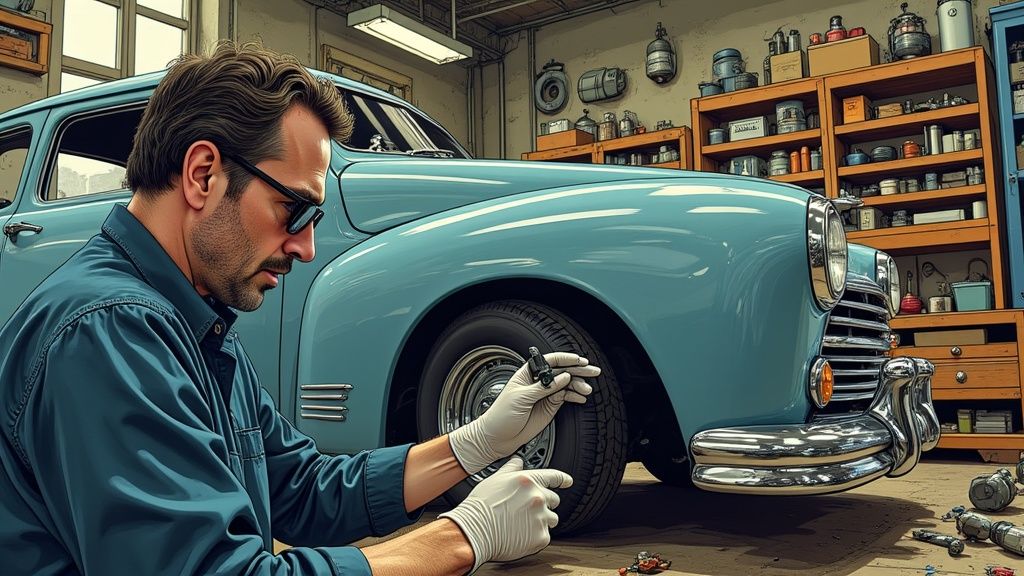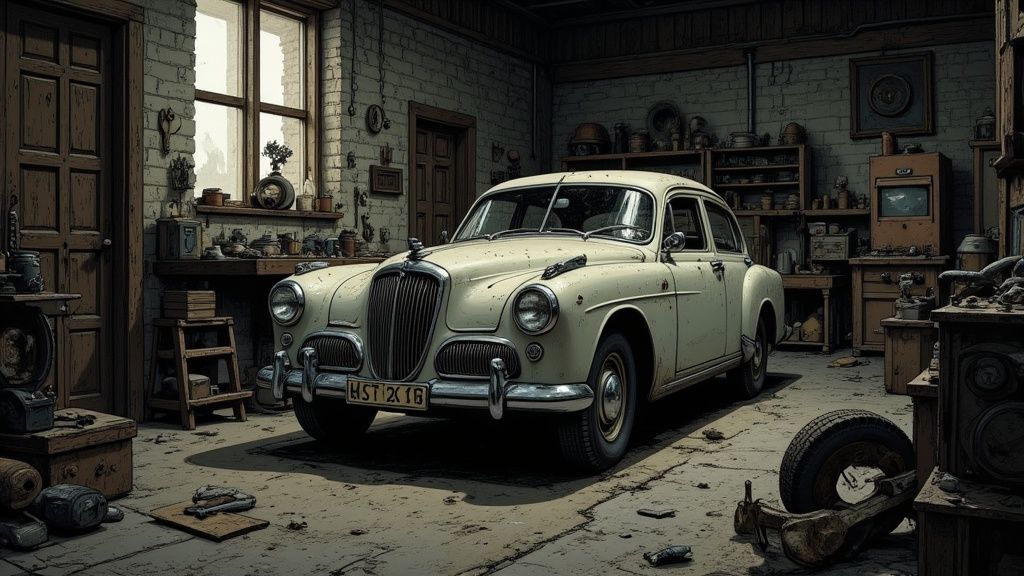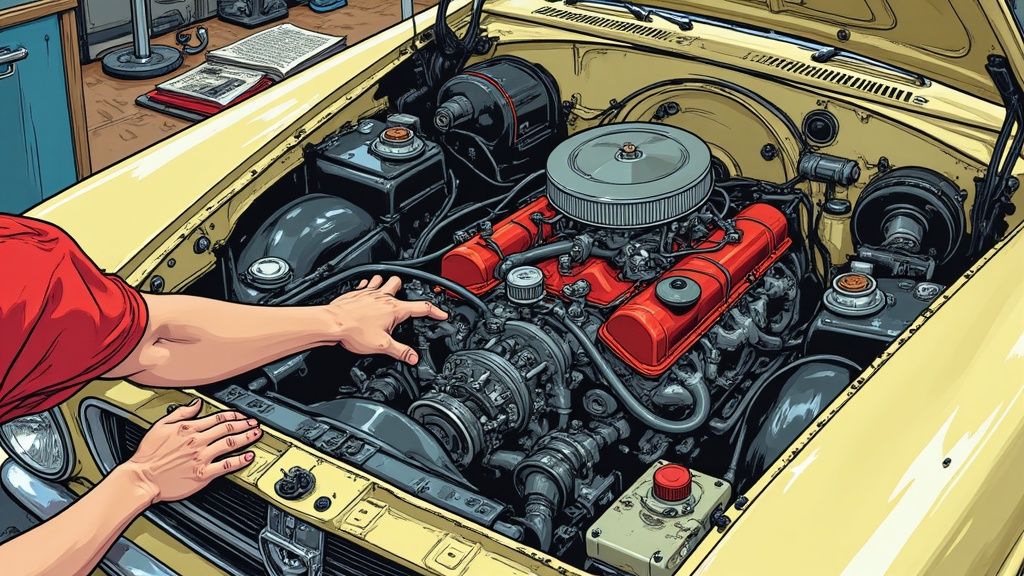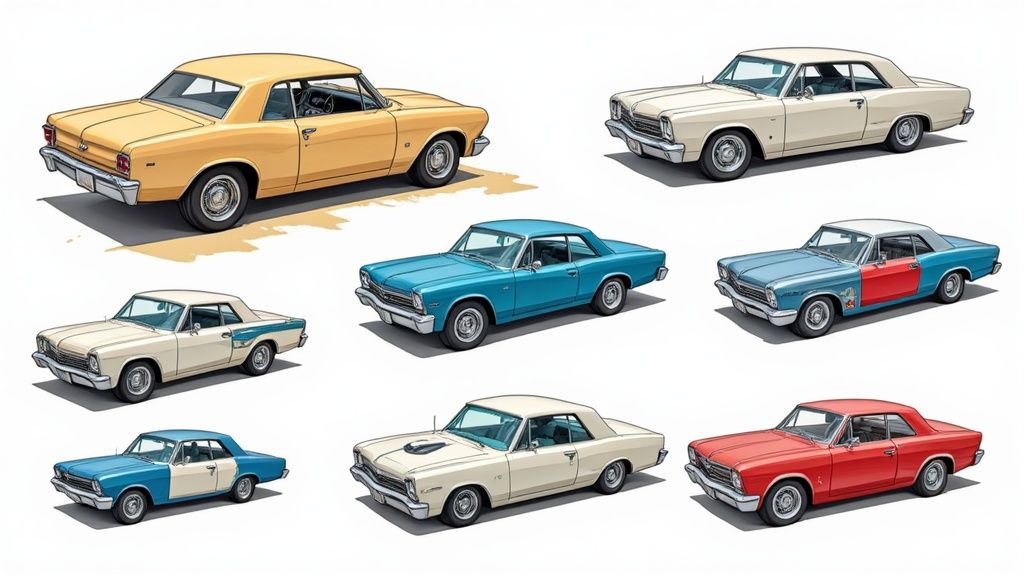
How to Restore Classic Cars: Expert Guide to Vintage Car Transformation
Understanding the Classic Car Landscape

Starting a classic car restoration takes careful planning and research. While it may be tempting to jump right in, understanding current market conditions, parts availability, and project scope will set you up for success. A thoughtful approach at the beginning helps avoid costly mistakes down the road.
Identifying Promising Restoration Candidates
Choosing the right project car is a critical first step. Research different models while considering factors like parts availability, mechanical complexity, and potential value. Cars with readily available parts generally cost less to restore than those requiring rare components. Match the project to your skill level - beginners often do better starting with simpler restorations that provide good learning opportunities.
How “Classic” Cars Are Changing
The definition of what makes a car “classic” continues to shift. While classics traditionally meant 1960s and early 1970s models, the category now includes vehicles from the late 1970s through the 1990s. Rising prices for traditional classics have sparked interest in these newer options. Read more about this trend. This expanded definition gives restorers exciting new possibilities to explore.
Looking Past Surface Appeal
Smart restorers examine more than just a car’s looks. They carefully check structural integrity, mechanical systems, and electrical components. A shiny exterior might hide major problems, while a rough-looking car could have great restoration potential. Taking time for thorough inspection and research pays off.
Learning Key Restoration Lessons
Studying both successful and challenging restorations provides valuable knowledge. First-time restorers often run into problems by underestimating parts costs or time requirements. Learning from others’ experiences helps avoid common pitfalls. With good planning and realistic expectations, restoring a classic car becomes an incredibly rewarding project. Understanding the wider classic car landscape helps you make smart choices as you begin your restoration journey.
Maximizing Investment Potential in Classic Cars
A classic car restoration project can be both personally rewarding and financially beneficial. Success requires careful research, planning, and understanding of the market dynamics. Let’s explore the key aspects of turning a restoration project into a sound investment.
Understanding Market Trends and Values
Smart investors focus on thorough market research. They study historical price trends, identify undervalued models, and evaluate factors like rarity and originality. Cars with documented racing history or past celebrity ownership often command higher prices. Staying informed about market shifts helps spot opportunities before they become mainstream.
Calculating Restoration Costs and Building a Budget
Creating a detailed budget is essential before starting any restoration. Take time to research and document costs for parts, labor, and specialized services. Get multiple quotes from reputable restoration shops and add a buffer for unexpected issues. A well-planned budget helps prevent cost overruns that could diminish your return on investment.
Balancing Authenticity with Marketability
While preserving originality is important, strategic upgrades can enhance value. Consider period-correct modifications that improve reliability and safety without compromising character. However, avoid major changes that could turn away collectors who value authenticity. The key is finding the right balance between preservation and practical improvements.
The Importance of Documentation and Provenance
Keeping detailed records throughout the restoration process is crucial. Document all work performed, parts used, and maintain complete service history. Strong provenance significantly impacts resale value. The classic car market continues to show strength - research shows the global automotive restoration market reached USD 5.5 billion in 2022 and is expected to grow to USD 2.3 billion by 2030. Learn more about market growth trends here.
Case Studies and Expert Insights
Study successful restoration projects to learn valuable lessons. Analyze how experienced restorers approach challenges, make decisions, and achieve strong returns. Connect with classic car experts to gain insights on documentation best practices and market trends. Remember that a thoughtful restoration strategy combines preserving history with building long-term value.
Creating Your Ideal Restoration Workshop

Setting up a proper workspace is key for any successful classic car restoration project. While you don’t need an expensive professional setup, having an organized and well-equipped space will make your work much easier and more enjoyable. Let’s explore how to build a functional workshop that fits your needs and budget.
Essential Tools and Equipment
Start with the basics and add specialized tools as needed. Essential hand tools should be your first investment before moving on to power equipment and specialty items.
- Basic Hand Tools: Quality socket sets, wrenches, screwdrivers, jack stands, and safety equipment are must-haves for any restoration
- Power Equipment: Consider a good drill, grinder, and impact wrench to speed up work. Air tools offer extra power if budget allows
- Specialty Items: Engine hoists, transmission jacks and welding gear can be purchased later as specific projects require them
Organizing Your Workspace
Good organization saves time and prevents frustration. Create a layout that supports efficient workflow:
- Work Zones: Set up dedicated areas for engine work, bodywork, and painting to keep tasks organized and prevent cross-contamination
- Tool Storage: Use toolboxes, shelving and labeled storage to keep everything accessible and easy to find
- Proper Lighting: Install bright work lights and ensure good ventilation, especially for painting and bodywork areas
Smart Ways to Save Money
There are several ways to build your workshop without breaking the bank:
- Borrow When Possible: For rarely-used specialty tools, check if you can borrow from other restorers or rent as needed
- Buy Used: Look for quality used tools, especially for bigger equipment purchases
- Focus on Quality: Invest in good quality for frequently used items like wrenches - they’ll last longer and work better
Workshop Safety
Always put safety first in your restoration space:
- Eye and Ear Protection: Wear appropriate safety gear when using power tools
- Proper Protection: Use gloves and respirators when working with chemicals or paint
- Fire Safety: Keep fire extinguishers handy and be mindful of flammable materials
Following these guidelines will help you create an efficient workshop where you can focus on the rewarding work of bringing classic cars back to life. A well-planned space makes restoration projects more enjoyable and helps ensure quality results.
A Classic Car Restoration Guide
Mastering the Restoration Process
Classic car restoration is a detailed process requiring careful planning and dedicated effort. To stay organized, break down the project into clear phases to track progress and maintain momentum through what can be a long-term endeavor.
Documentation and Disassembly: The Foundation of a Successful Restoration
Proper documentation is essential before starting any disassembly. Take thorough photos from every angle, record existing damage, and catalog all parts to ensure smooth reassembly later. Auto Service Logger can help organize digital documentation like photos, videos, parts lists and receipts.
The disassembly phase requires methodical organization. Label each part and fastener carefully as you remove them. Think of it like taking apart a complex puzzle where every piece needs to be accounted for and its original location recorded.
Bodywork and Mechanical Rebuilding: Breathing New Life into Your Classic
Bodywork involves rust repair, panel replacement, and fixing dents. This phase demands patience and precision to transform damaged metal into smooth, flowing bodylines ready for paint.
During mechanical rebuilding, you’ll tackle the engine, transmission and drivetrain. This involves disassembling, cleaning, inspecting and rebuilding or replacing components. Success requires technical knowledge and understanding how each part functions together.
Electrical System Restoration and Modern Safety Features: Balancing Old and New
The electrical system needs careful inspection of wiring, connections and components. A complete rewiring may be needed - this provides a chance to add modern upgrades while keeping the original look. Converting to a 12-volt system can boost reliability without changing aesthetics.
Adding modern safety features improves drivability while preserving classic character. Consider upgrades like seatbelts, better brakes, and enhanced lighting for safer road use. This lets you enjoy vintage style with current safety standards.
Sourcing Parts, Managing Timelines, and Maintaining Motivation: Overcoming Challenges
Finding parts can be challenging but rewarding. Connect with other enthusiasts, join forums, and visit swap meets to locate rare components. Think of it as a treasure hunt requiring persistence to complete your automotive puzzle.
Set realistic timeline and budget expectations. Most restorations take longer and cost more than planned. Break the project into smaller goals and celebrate progress to stay motivated. Focus on the end vision while working through each phase methodically.
Remember what inspired you to start this journey. Picture your finished classic car and take pride in each milestone achieved. Though restoration presents challenges, seeing your vision become reality makes the effort worthwhile.
Building Your Classic Car Network

The true magic of classic car restoration goes beyond the mechanical work - it’s about the community you build around your passion. Having a strong support network provides essential knowledge, resources, and encouragement throughout your restoration journey. Building meaningful relationships within the classic car community is just as vital as developing technical skills.
Connecting With the Classic Car Community
The classic car community offers incredible opportunities to learn and grow. Car clubs focused on specific makes and models are excellent starting points for meeting fellow enthusiasts and learning restoration techniques. Online forums and social media groups connect you with a worldwide network where you can ask questions, find parts, and stay informed about events. Regular participation helps you make the most of these valuable community resources.
Finding Reliable Parts and Services
For any restoration project, having trusted parts suppliers and specialists is crucial. A good network helps simplify the search for components, especially rare ones. Experienced restorers often have connections with reliable vendors they can recommend. Building relationships with skilled classic car mechanics ensures expert care for your vehicle. Car shows, swap meets, and online communities are great places to find these valuable connections.
The Value of Mentorship
Having an experienced guide in classic car restoration can be game-changing for newcomers. A mentor can help you avoid common pitfalls, choose appropriate projects, and tackle complex challenges effectively. Their personalized guidance saves time and money while preventing frustrating mistakes. Many seasoned enthusiasts enjoy sharing their expertise with passionate newcomers - don’t hesitate to reach out to those whose work inspires you.
Contributing to the Community
A strong network thrives on reciprocity. Sharing your own restoration experiences helps others on their journeys. Consider volunteering at local car shows or helping other enthusiasts through online forums. This builds stronger connections and supports the hobby’s growth. Currently, 43 million cars in the US are considered collector vehicles - about 16% of all cars nationwide. The collector market continues growing, with values rising for 15 consecutive months. For detailed market data, visit Hagerty’s collector car market insights. Track your restoration progress using Auto Service Logger to document and share your journey. Your active participation helps turn solo restoration work into a shared adventure filled with friendship and knowledge exchange.
Preserving Your Car’s Legacy
Restoring a classic car involves much more than mechanical work - it’s about preserving automotive history. By documenting each step of your restoration journey, you create lasting value for your vehicle, both emotional and financial. Proper documentation helps tell your car’s unique story and builds its provenance, which can significantly affect its future worth.
Researching and Verifying Your Vehicle’s History
Start by discovering your car’s background story. Look up records in online databases, historical societies, and talk to previous owners. Document key details like manufacturing date, original specifications, and notable events from its past. Understanding details like whether your car was a special edition model helps guide restoration choices for maximum historical accuracy.
Maintaining Detailed Restoration Records
Record-keeping during restoration serves multiple purposes - it keeps your project organized and proves the quality of work completed. This becomes especially valuable when selling or displaying the car.
- Photos: Take detailed pictures before, during, and after each restoration phase to show the transformation
- Parts Documentation: Save all receipts and parts information to verify authenticity
- Work Records: Note time spent on each task to track the full restoration investment
Creating a Compelling Narrative
Your restoration documentation tells a story. Combine your research, photos, receipts and work logs into a complete portfolio. When you present potential buyers with both a beautifully restored car AND a detailed account of its journey, you create much stronger interest and value.
Digital Record-Keeping and Restoration Portfolios
Modern digital tools make organizing restoration records simple. Auto Service Logger provides a central place to store all your documentation securely. Having digital backups protects important records and makes sharing progress with other enthusiasts easy.
Enhancing Value Through Documentation
Good documentation helps establish your classic car’s provenance and builds trust with future buyers. Cars with clear, verifiable histories tend to command higher prices. When you combine excellent restoration work with thorough documentation, you transform a project car into a treasured collectible that will maintain its value for generations.
Start preserving your car’s story today with Auto Service Logger. Learn more and sign up for a lifetime membership.